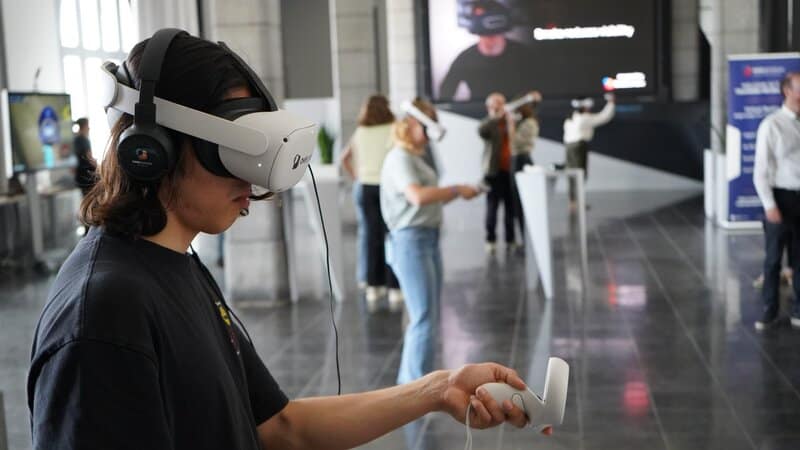Augmented reality has the potential to improve the services that governments can offer citizens, and the efficacy of public infrastructure planning and management.
In a nutshell, augmented reality involves displaying text, graphics and audio over the real-world. This typically happens by displaying information based on what the user is looking at. These allow the user to interact with the data or systems they see, such as enabling public workers to get information about an asset or confirm a fault they are working on by looking at it.
One of the great things about augmented reality is that users do not need any specialized tech to access it. Any modern smartphone can provide access to AR experiences, opening up more possibilities for public use.
This technology has numerous potential uses within the public sector, and is already being put to use in countries throughout the world.

Uses of AR in the Public Sector
Augmented reality offers many uses in the public sector. Many of these are already seeing use in the real world by governments around the globe. Besides uses for public sector workers, AR can give governments a more direct way to educate and communicate with citizens.
Citizen Engagement in Public Works Planning
Augmented reality is an opportunity to engage citizens in local policies and public works planning. Most people don’t even know where to learn about the creation of new policies and projects, or voice their opinions.
Augmented reality can make these processes apparent and accessible for everyone. In 2018, Seattle city planners were assessing plans to rezone neighborhoods. Before going ahead with any plan, they needed to gather feedback from locals. Their solution combined interactive maps with augmented reality visualizations of the proposed changes to neighborhoods. As a result, residents could give their input based on a better understanding of how the rezoning would impact them.
This approach can be applied to any public works planning. An augmented reality app could educate people about the planned works, and make it easy for them to give feedback.
Using AR, people could use their phones to view a 3D render of the proposed plans from any angle. Furthermore, tapping parts of the AR display could reveal more detail about that part of the project, and allow users to leave their comments or feedback. This whole experience could be accessed in seconds by any passerby simply by scanning a QR code.

Asset and Infrastructure Maintenance
Augmented reality can also visualize and provide more data about assets and infrastructure. As a result, public sector workers can maintain public assets based on more accurate data.
Maintaining and repairing utility networks such as water supply can require workers to access large amounts of data about an asset. Finding, updating and sharing all of the right data to the right people can be a major time bottleneck.
Augmented reality can streamline these processes by making the key data available to field workers at a glance. This can aid field workers in working more accurately. For example, by visualizing the position of a pipeline they are digging for.
Furthermore, AR solutions also allow field workers to talk with remote specialists and supervisors more effectively. Remote experts can view exactly what field workers are seeing and provide real-time assistance. This could involve sending further information, diagrams or even video to discuss an issue or instruct on a solution with greater clarity.
Public Safety and Emergency Services
Augmented reality can improve the safety of modern cities as well as their efficiency.
For example, augmented reality navigation aids such as a head-up display on the windscreen of emergency vehicles could improve the speed and safety of their response. This could guide police, ambulance drivers, and firefighters to drive safely and follow the fastest route. The same systems can also deliver updates about environmental conditions and road hazards, and further details about an emergency incident.
Emergency responders can also benefit from augmented reality outside of their vehicles. An AR display with sensors can give better visibility through smoke, fire, and other environmental conditions. Similarly, it can give extra details such as information about the inside layout of a building, what to expect when arriving at a situation, or further details about key subjects.
Augmented reality offers help to citizens directly as well as through aiding emergency responders. This could involve using their phones to get visual and audio guidance on finding evacuation routes, shelter, or emergency aid in a disaster. Such a usage could protect citizens by using real-time updates to steer people away from danger, or towards safety.

Culture, Heritage and Tourism
Besides its uses in vital public works, planning and emergency services, augmented reality technology can support the heritage and tourism of cities, museums, and more. For example, visitors and residents alike can access interactive information about attractions, monuments and exhibits simply by pointing their phone camera at them. As a result, tourists can more easily gain a deeper insight into the importance and history of what they are seeing.
The National Museum of Singapore recently introduced an immersive art installation that makes extensive use of AR technology, enabling visitors to interact with and learn more about the wildlife featured in the exhibit.
To learn more about how augmented reality could help your next infrastructure project, get in touch with one of our AR experts today.
Source of this publication: https://onebonsai.com/blog/augmented-reality-for-the-public-sector/

